What is Drive about?
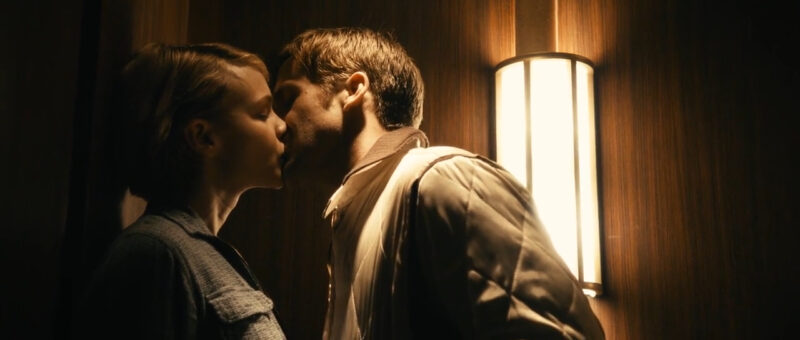
Drive explores the conflicting personas we feel torn between—the classic tale between the light and the dark—as well as the personal cost of violence. The central character, a stunt driver by day and getaway driver by night, embodies this duality, as he lives a life that constantly waves between quiet contemplation and sudden eruptions of brutality. He strives to keep his life as calculated and calm as possible, even when carrying out life-threatening missions—yet, his personal decisions, his past constantly come back to haunt him and disrupt any glimpse of normalcy, any semblance of tranquility. He wants to push towards the light, but the darkness constantly creeps nearby ready to pull him back in.
Every component of director Nicolas Winding Refn’s aesthetic explores this struggle: the Driver’s romantic interest, Irene (whom represents a second chance to find love and build a family outside his destructive lifestyle), and her son Benicio (whom represents childhood innocence and a boy with an entire future to shape from scratch) represent qualities of life he strives to protect; the pervasive use of neon aesthetic and the synth-heavy soundtrack juxtapose the gritty reality of the criminal underworld with the protagonist’s desire for a simpler, brighter existence; and the act of driving represents an escape, a chance to coast and dictate the mood and feel of your existence, even when you seemingly have no control over the whims of a corrupt society. This melancholic film ultimately suggests that we cannot always control our fates once we’ve made certain decisions. The Driver may want to live a different life—but that’s not always a realistic option. Because of his decisions, he seems unequipped to handle any sort of normalcy.
So what is the film ultimately saying? It could very well be a dour, pessimistic statement about humanity and our inability to control our paths. But there’s a more optimistic tone when we consider the film’s reflective, contemplative aesthetic. Just because certain decisions have doomed us to certain roads doesn’t mean that we can’t make the most of those roads. The Driver was further and further sucked into Bernie and Nino’s dark world until there was no escape. But within that world The Driver enacted some positive change: he was able to protect Irene and Benicio. So while The Driver may die in the end (which is ambiguously stated), he drives away on his own terms, down a road he built himself. There’s a calm acceptance to the end of the film that speaks to the natural inevitability of life we must all comes to terms with.
Cast
- Ryan Gosling – The Driver
- Carey Mulligan – Irene Gabriel
- Bryan Cranston – Shannon
- Albert Brooks – Bernie Rose
- Oscar Isaac – Standard Gabriel
- Christina Hendricks – Blanche
- Ron Perlman – Nino ‘Izzy’ Paolozzi
- Kaden Leos – Benicio Gabriel
- James Biberi – Chris Cook
- Jeff Wolfe – Assassin in the tan suit
- Russ Tamblyn – Doc
- Andy San Dimas – Dancer
- Hossein Amini – Writer
- Nicolas Winding Refn – Director
The ending of Drive explained

A recap of Drive‘s ending
In the final sequences of Drive, The Driver, finds himself in a complex and dangerous situation. His association with Irene’s husband, Standard, leads him into a botched heist that results in the death of Standard and the theft of a significant amount of money from the mob. After discovering that Shannon told Bernie and Nino about Irene and Benicio, he is forced to take out Nino before setting up a final confrontation with Bernie to make sure he can keep them safe.
During the meeting, Bernie proposes a deal: the stolen money for Irene and Benicio’s safety. The Driver, however, will always be looking over his shoulder, under threat from the criminal underworld. In the following scene, they walk out to The Driver’s car to retrieve the money. As they exchange the money, Bernie stabs The Driver in the stomach. However, The Driver anticipated this betrayal and retaliates, killing Bernie. The Driver has been fatally wounded, but manages to get back inside his car.
With the money and the threat gone, The Driver ensures Irene and Benicio’s safety. He rests in his car, heavily bleeding. As he sits, he clutches the wound in his stomach. He remains motionless, staring into the distance, leaving the audience wondering about his fate. He then drives away, leaving Bernie’s dead body in the parking lot.
The next scene shows Irene knocking on The Driver’s apartment door. When there’s no response, she goes to knock again but stops herself. Her face expressing concern and confusion, she has perhaps realizes that The Driver will not be coming back.
We then return to The Driver. Still in his car, he drives through the city at night, seemingly leaving behind the life he had started to build with Irene and Benicio. The movie concludes with his car disappearing into the darkness.
The meaning of Drive‘s ending
In order to unpack the deeper meaning of Drive‘s ending, I feel the best place to start is the song that closes the film: “A Real Hero” by College and Electric Youth. This song serves as an auditory motif that provides a deeper understanding of The Driver’s character and his search for identity. The song’s use in pivotal scenes underscores The Driver’s transformation, and its evocative lyrics offer a significant commentary on his character arc. We first hear the song when he drives Irene and Benicio around Los Angeles, and then again at the end of the film as he drives into the night—this juxtaposition is very purposefully done.
The lyric “A real human being, and a real hero” forms the crux of The Driver’s identity exploration. The repeated use of the term “real” highlights The Driver’s struggle to reconcile the disparate parts of his identity: the caring figure in Irene and Benicio’s lives versus the efficient, violent criminal. This is why we first hear the song when he drives Irene and Benicio, as it’s indicative of The Driver’s desire to fulfill this family’s much-needed fatherly role.
Think about the song’s verses. Here’s the first verse:
Back against the wall and odds
With the strength of a will and a cause
Your pursuits are called outstanding
You’re emotionally complexAgainst the grain of dystopic claims
Not the thoughts your actions entertain
And you have proved to be
And the second verse:
A pilot on a cold, cold morn’
155 people on board
All safe and all rescued
From the slowly sinking shipWater warmer than his head so cool
In that tight bind knew what to do
And you have proved to be
These stories paint a picture of somebody who envisions themselves as a hero. The scenarios the song paints require someone who is courageous and valiant, someone who fights for those who cannot. Thus, the song’s refrain suggests an ideal to aspire to, a beacon in his quest for self-definition. It implies that a “real hero” and a “real human being” are not distinct entities but can coexist within the same person, reflecting the duality within The Driver—he imagines a life for himself outside the one he actually lives.
As the narrative unfolds, The Driver’s actions purposefully align with the “real hero” described in the song. His willingness to put himself in harm’s way to protect Irene and Benicio, his confrontation with Bernie, and his ultimate sacrifice to ensure their safety, all resonate with the song’s depiction of a hero. By making these choices, he is not discarding his past but integrating it into a new identity, one that echoes the qualities of the “real hero” outlined in the song.
Here’s the tension, though: The Driver is desperate to paint this picture of himself because he desperately seeks to abandon the life he lives. He could never be a husband to Irene or a father to Benicio because of his criminal life—Standard is living (note the irony here) proof of that. So while he is playing a heroic figure by fighting Bernie and Nino, he’s actually getting pulled deeper and deeper into that lifestyle—until it costs him his own life.
So as The Driver drives away into the night, we are left with a question: Does he live or die? Does he make it out of the criminal world and find Irene and Benicio? Or does he lose them and any semblance of a normal, happy life forever?
But let’s make that question a little deeper. As The Driver drives away at the end, perhaps what we ask instead is: How does The Driver view himself as he drives away? Did he become, as the song suggests, a “real hero”?
In this light, the song plays a significant role in elucidating the film’s ending. As The Driver drives into the night, wounded and alone, the song’s refrain underscores the transformation he believes he’s undergone. Despite his violent past and the brutal world he comes from, he has, in his own eyes, proven himself to be a “real hero” through his selfless actions. His decision to isolate himself from Irene and Benicio, despite his evident longing for connection, epitomizes his heroism, highlighting the sacrificial nature of his journey.
But isn’t there more to consider? What about Irene and Benicio in the wake of all this violence and greed? That’s why we see Irene knock on his door, only to walk away with the realization that The Driver will never be there for them because of his destructive lifestyle. What good is he to her, ultimately? What kind of hero would do this? What good is it if The Driver views himself as a hero if nobody else does?
This burning tension fits nicely with the film’s contemplative tone. When violence and vengeance enters the picture, the energy is hectic and The Driver completely loses control of himself. Which is why he constantly seeks calmness and peace in his life. The music he plays, the rules he outlines, the quiet drives he takes around the city, the loving smiles he shares with Irene—it’s all in service of pushing away the darkness that pervades his everyday. So here at the end, you can view it as a cathartic victory that The Driver drives into the night on his own terms, with the kind of calmness he hoped to achieve with Irene and Benicio. Perhaps it’s a fantasy that The Driver became a “hero.” But it’s his fantasy. He understood what needed to be sacrificed in order to protect the people he loves.
The themes and meaning of Drive
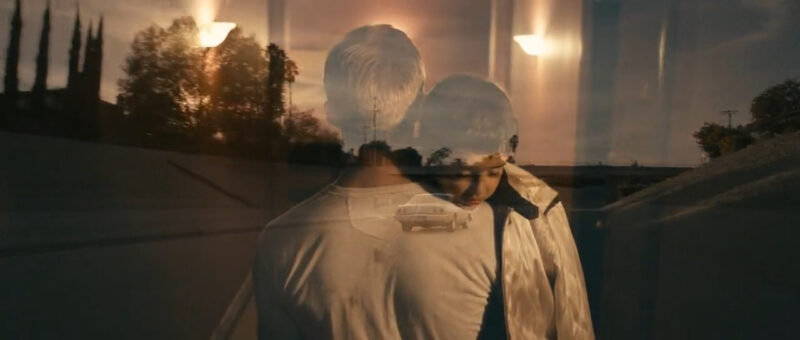
The search for identity
A major theme in Drive is the search for identity, which takes center stage through The Driver’s journey. The character, portrayed with a quiet intensity, is a mysterious figure whose lack of a proper name and backstory accentuates his enigmatic nature. This anonymity serves to emphasize his struggle for self-discovery and understanding.
The Driver’s iconic scorpion jacket further symbolizes his attempt to define his identity. The scorpion is an emblematic representation of his dangerous and unpredictable nature, yet it is also a protective shell, a way to conceal his vulnerability. In the film, the jacket acts as a visual representation of his persona, a marker that differentiates his two distinct lives: the gentle, caring neighbor and the ruthless criminal.
As the story unfolds, The Driver’s search for identity becomes increasingly apparent through his relationships with other characters. With Irene, he discovers a sense of belonging and purpose that had previously eluded him. The bond he forms with Irene and her son Benicio highlights his yearning for connection, stability, and an opportunity to embrace a more wholesome life. This relationship offers a glimpse of the person The Driver could be if he were to abandon his criminal lifestyle.
However, The Driver’s past and the criminal world he inhabits continue to exert a powerful pull on him. Characters like Bernie and Nino represent the underworld that threatens to derail his path to redemption. Their presence serves as a reminder that despite The Driver’s desire to change, the world of crime and violence remains an inescapable part of his life.
In the climactic confrontation with Bernie, The Driver’s readiness to leave the life of crime is put to the test. When Bernie stabs him, The Driver is forced to defend himself, ultimately killing Bernie. This act of self-defense, however, reinforces the reality that his criminal past will continue to haunt him, making it difficult to fully embrace the better life he desires with Irene.
In the end, The Driver’s search for identity remains an ongoing struggle, highlighting the complexity of human nature and the perpetual quest to define ourselves in a world full of contradictions. The film’s ambiguous conclusion, with The Driver driving away into the night, leaves the audience pondering his fate and reflecting on the universal journey of self-discovery and the search for meaning in our lives.
The impact of isolation and loneliness
Drive presents a profound exploration of isolation and loneliness, using its setting and characters to mirror these themes. Los Angeles, with its sprawling cityscape and endless highways, serves as a backdrop that emphasizes the characters’ alienation.
The Driver is a solitary figure who seems detached from the world around him. His apartment, sparse and empty, mirrors his emotional landscape. His profession as a getaway driver further emphasizes his solitude, as he navigates the city’s sprawling streets alone, always in motion but never forming meaningful connections.
Even in his relationship with Irene, there’s an undercurrent of solitude. Though he cares deeply for her and Benicio, he’s still an outsider, separated by his dark past and dangerous lifestyle. The scene in which The Driver watches Irene and her family from a distance at the party, despite being in the same room, encapsulates this feeling of emotional detachment.
Ironically, the car, typically a symbol of freedom and mobility, serves as a vessel of isolation for The Driver. He spends most of his time enclosed within the metal confines, physically distanced from others. The scene where he drives through the night after the pawn shop heist, his face illuminated only by the dim dashboard lights, is a powerful visual representation of his solitude.
The film uses silence to intensify the feeling of desolation. Much of the film unfolds with minimal dialogue, leaving the characters to dwell in their own thoughts, separated not just physically but emotionally as well—ultimately, the film’s entire aesthetic is informed by the feeling of isolation. The Driver, in particular, speaks very little, which further isolates him from others and underlines his loneliness.
Why is the movie called Drive?
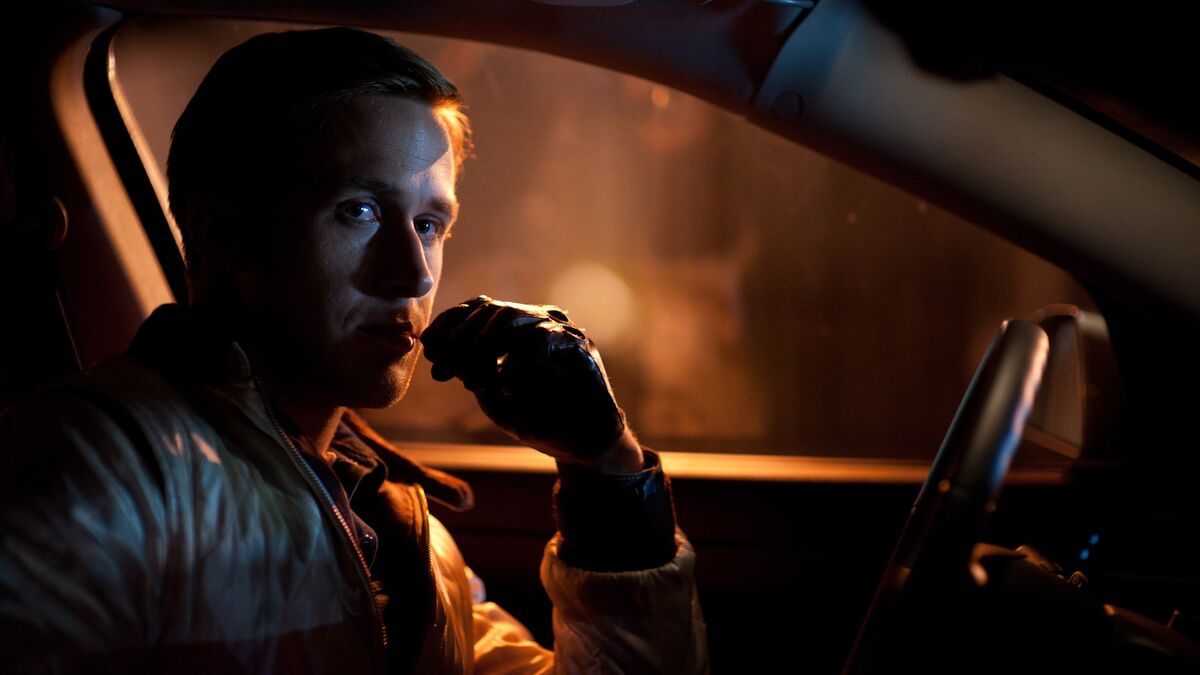
Drive isn’t just a title—it’s a thematic emblem of the movie’s exploration of identity, purpose, human connection. On the surface, it refers to The Driver’s occupation as a Hollywood stunt driver and his moonlighting gig as a getaway driver. But the title’s deeper meaning explores the forces behind The Driver’s actions and the transformative journey they undertake.
The title is an embodiment of The Driver’s singular focus and purpose. His entire existence is defined by his role as a driver—it’s what he excels at, and it’s where he finds both purpose and anonymity. His superior driving skills are a metaphor for his journey through life: calculated, efficient, yet profoundly isolated. He is the embodiment of a man driven by his craft, yet paradoxically trapped within it.
The act of driving serves as an apt metaphor for the narrative trajectory and The Driver’s existential journey. He is a man of few words, navigating life much like the labyrinthine streets of Los Angeles he traverses: detached, meticulous, and with a relentless focus on the road ahead. He drives forward, ostensibly away from the dangerous life he leads towards a calmer one, yet he is constantly entrapped by the winding streets of L.A. His quiet drives allow for contemplation, yet sometimes those drives are disrupted and thrown into disarray. He is constantly trying to control the mood of his settings, trying to create a harmonious link between the life he’d like to live and the life he’s living. In this vein, Drive signifies the protagonist’s relentless pursuit of purpose and identity.
The title hints at the raw, primal drives that underscore the movie’s more violent scenes. These moments, initially jarring against the backdrop of the film’s slow-burning narrative, remind us that beneath the protagonist’s stoic exterior lies an explosive capacity for violence. This is not violence for violence’s sake. Instead, it’s a visceral manifestation of his protective drive towards those he cares about, particularly Irene and Benicio. The juxtaposition of his calculated demeanor during his driving and his raw, uncontrolled violence reflects the dual nature of our drives, which can manifest as both creative and destructive forces.
Drive resonates with the theme of desire—the longing for connection, belonging, and love. The protagonist’s blossoming relationship with Irene and Benicio illuminates his longing for a sense of family and normalcy. Despite his life’s dangerous aspects, he’s driven by a profound desire to connect and protect. This drive, though it leads to violence and tragedy, is portrayed with an underlying sense of poignancy and humanity.
Ultimately, the title encapsulates the broader existential journey of its characters. They’re all driven by something, be it ambition, survival, love, or redemption. The movie subtly asks the audience what drives them in their lives, reflecting on the roads we take and the detours that define us.
Important motifs in Drive
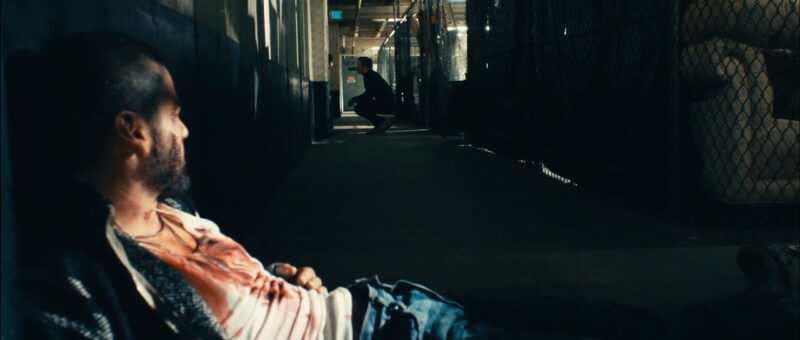
The Scorpion and the Frog
The story of The Scorpion and the Frog, referenced through The Driver’s scorpion-embroidered jacket, is a powerful motif in Drive. This fable, about a scorpion that stings a frog even though it means certain death for both of them, is emblematic of the immutable nature of character. The Driver, like the scorpion, is bound by his inherent nature. Despite his attempts to foster a normal, peaceful life with Irene and Benicio, his violent past and innate characteristics constantly pull him back. This motif is especially poignant in the climactic scene where The Driver confronts Bernie, knowing well that it may lead to his own demise. The story reflects the reality that The Driver cannot escape his past, that his decisions doom him to a certain outcome.
“A Real Hero”
The song “A Real Hero” by College and Electric Youth serves as a recurring musical motif in Drive, providing an mirror to The Driver’s character evolution and his complex relationship with Irene and Benicio (as we discussed in the ending section). Its two significant occurrences in the movie underscore different stages in The Driver’s journey, creating a poignant resonance between the melody and the narrative.
During its first occurrence, the song underscores a moment of idyllic respite in The Driver’s life. As he drives through the Los Angeles River concrete bed with Irene and Benicio, the lyrics “A real human being, and a real hero” highlight his aspiration for a normal, peaceful life. At this point in the film, The Driver is shown to be striving for human connection and to be a heroic figure in the lives of Irene and Benicio. This scene is imbued with a sense of tranquility and hope, reinforced by the uplifting melody and lyrics of the song, suggesting the potential for The Driver to change his life trajectory.
In stark contrast, the second instance of the song during the final scene of the film serves as a poignant counterpoint to the earlier moment of hope. The Driver, now wounded and driving away into the night, embodies the lyrics of the song in a much more complex way. The song now underscores his solitude and sacrifice, highlighting the tragic paradox of his journey. He has become the hero he aspired to be for Irene and Benicio, but in doing so, he has isolated himself from them forever.
The stopwatch
The stopwatch The Driver uses in his jobs is a recurring motif that signifies precision, control, and the fleeting nature of time. It underscores The Driver’s meticulous nature and his ability to manipulate time to his advantage, as evident in the opening getaway scene. However, it also serves as a reminder of the transitory nature of his peaceful moments with Irene and Benicio. The stopwatch, therefore, becomes a symbol of his dual existence: a precision tool for his criminal activities and a metaphorical ticking clock for his ephemeral happiness.
Cars and driving
Cars and driving form a central motif in the film, representing freedom, control, and escape. The Driver’s skills behind the wheel are his greatest asset, allowing him to navigate the dangerous world of crime. Cars offer him control, a space where he excels, and a means to escape when situations spiral out of control. However, in the film’s conclusion, the car also becomes a symbol of his isolation as he drives off into the night, leaving behind a chance at a normal life.
Masks
The motif of masks in Drive symbolizes duality and hidden identities. The Driver dons a mask during his stunt driving jobs, signifying the dichotomy between his public and private personas. Yet the mask means more to his personal life that he may have realized, as his search for identity throughout the film comes to parallel his career. The mask then becomes a tool for his criminal life, for his mission to become a “hero” and protect Irene and Benicio. The faceless man he becomes with the mask serves as a blank slate—a chance to embody the hero he envisions. In the land of Hollywood, he’s ultimately able to realize the hero he fantasizes about.
The city at night
The depiction of Los Angeles at night is another recurring motif in Drive. The city’s neon-lit nightscape reflects the darker, hidden aspects of the characters’ lives. The seedy underbelly of the city mirrors The Driver’s clandestine activities and underscores the dichotomy between his quiet, daytime existence and his high-octane, dangerous nocturnal life. This motif comes full circle in the film’s final scene, where he drives off into the night, symbolizing his acceptance of his dual existence and the enigmatic nature of his life.
Questions & answers about Drive
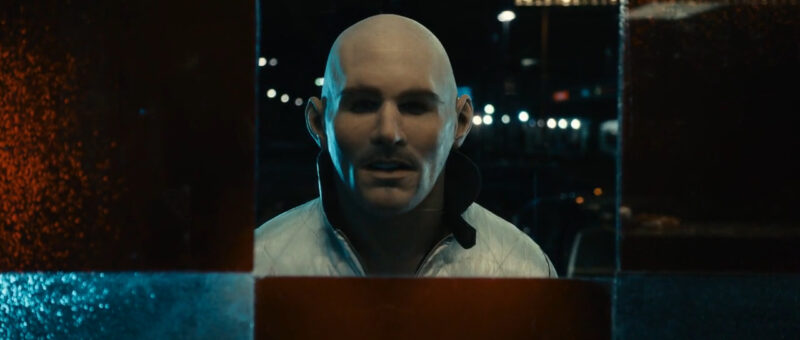
Why does The Driver wear a mask when he kills Nino?
The use of the mask in The Driver’s climactic confrontation with Nino has profound implications. It’s a visual representation of The Driver’s internal duality, a concept that operates at the core of the film. The mask, an artifact from his stunt driving for Hollywood films, is an emblem of the artificial identities he assumes, separating his violent deeds from his true self.
Throughout Drive, we witness a deeply divided character. On one side, there’s the quiet, compassionate man who connects with Irene and her son, Benicio. On the other, we see the ruthless, precise criminal, who navigates the treacherous underbelly of Los Angeles with a cold, unemotional demeanor. These two identities, the nurturer and the destroyer, have existed in parallel, with The Driver skillfully compartmentalizing his life.
However, when Irene and Benicio’s safety is jeopardized, these two distinct identities collapse into one. By donning the mask during his confrontation with Nino, The Driver is no longer able to hide behind the comfort of his dual personas. The mask, then, becomes an externalization of his internal conflict, a symbolic acceptance of his unified identity that has emerged from the fusion of compassion and violence. In essence, it’s not just the caring neighbor or the steely professional who faces Nino—it’s a comprehensive embodiment of both, an avatar of retribution.
Why doesn’t The Driver talk very much?
The Driver’s reticence is a powerful character trait that underpins his enigmatic persona, and it’s instrumental in building the thematic structure of the film. His silence is not merely a reflection of his character but a narrative device that reflects his existence within the film’s universe.
In the world of crime, he must remain detached, untraceable, and professional. His silence in these circumstances is a survival strategy: the less he reveals about himself, the safer he remains. His sparse dialogue creates an aura of mystery, casting him as an unreadable figure whose motivations and emotions can only be discerned through his actions rather than his words.
However, his silence extends beyond his professional life. It signifies a deeper disconnection from the world around him, a man who is emotionally distant due to the perilous nature of his existence. His connection to Irene and Benicio is the only emotional bond he allows himself, which is why he communicates more openly with them. His taciturn nature, therefore, is a protective shield, a way to maintain emotional distance and control in a world fraught with danger.
Why doesn’t The Driver go back to Irene at the end of the movie?
The Driver’s decision not to return to Irene at the end of Drive is a heartrending resolution to his struggle with his dual identity. It encapsulates the tragic underpinning of the film’s narrative and provides a profound commentary on the incompatibility of love and violence.
Throughout the film, The Driver’s connection with Irene and her son provides a stark contrast to his life in the criminal underworld. They offer him a glimpse of an alternative life, one marked by ordinary happiness and simple pleasures. However, his involvement in crime and ensuing violence shatters this idyllic vision. When his two worlds collide, it’s Irene and Benicio who suffer, causing The Driver to confront the destructive ramifications of his lifestyle.
His decision to not return to Irene signifies his acceptance of the impossibility of reconciling his love for them with the danger that his life poses. It’s a sacrifice, a testament to his deep affection for them. His love for Irene and Benicio is reflected not in a desire for proximity but in a selfless act of ensuring their safety. By removing himself from their lives, he hopes to shield them from the violent world he is enmeshed in. It’s an act of penance and a tragic acceptance of his fate—to forever remain on the periphery of the “normal” life he yearns for.
Why does Nino try to rob the pawn shop money from The Driver and Standard?
Nino’s attempt to rob the money from The Driver and Standard is driven by his aspirations for power and control. Nino feels disrespected and underestimated by his fellow mobsters because of his Jewish heritage in a predominantly Italian crime syndicate. The pawnshop robbery was intended to be a setup: Standard would be killed, the money would return to Nino, and the East Coast mobsters he owed would be none the wiser.
However, The Driver’s involvement complicates things. Nino didn’t anticipate an experienced wheelman who could potentially trace the setup back to him. Hence, Nino attempts to eliminate all loose ends, triggering the violent chain of events that transpire throughout the film. It’s a classic tale of greed and ambition in the criminal underworld, further emphasizing the dangerous and volatile environment that The Driver operates within.
Now it’s your turn
Have more unanswered questions about Drive? Are there themes or motifs we missed? Is there more to explain about the ending? Please post your questions and thoughts in the comments section! We’ll do our best to address every one of them. If we like what you have to say, you could become part of our movie guide!
